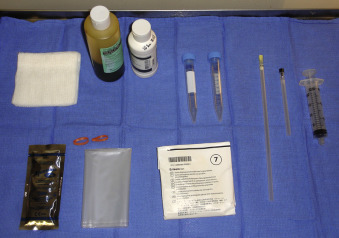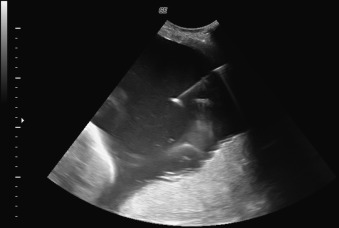Abstract
Amniocentesis is a procedure in which a needle is used to transabdominally withdraw amniotic fluid from the amniotic sac. Amniocentesis is most commonly indicated for prenatal diagnosis and for fetal lung maturity. Other indications include amnioreduction, diagnosis of an intraamniotic infection, confirmation of preterm premature rupture of membranes with an amnio dye test, evaluation of hemolytic anemia in the fetus, diagnosis of hemoglobinopathy, and diagnosis of neural tube defects. This chapter provides an in-depth discussion regarding the indications, risks, technique, and complications associated with this procedure.
Keywords
amniocentesis, genetics, lung maturity
Introduction
Amniocentesis is a procedure in which a transabdominally placed needle is used to withdraw amniotic fluid from the amniotic sac. “Early amniocentesis” (<15 weeks’ gestation) should be avoided because of increased complications, including a higher fetal loss rate and an increased risk of talipes equinovarus.
Procedure
Description, Technique, and Equipment
Amniocentesis should be performed by a physician who has experience with the procedure and ultrasound (US). Before amniocentesis, the patient should be counseled regarding the purpose, risks, and alternatives to the procedure, and informed consent should be obtained. US examination should be performed initially to establish fetal position, fetal heart rate, placental location, and placental umbilical cord insertion site. The presence of an amnion-chorion separation, which may be noted up to 17 weeks’ gestation, should be documented. If the location of the amnion-chorion separation cannot be avoided during amniocentesis, one may consider postponing the procedure to a gestational age when the amnion and chorion are fused.
An optimal needle insertion site should be selected. The maternal bowel and bladder should be identified and avoided because traversing the maternal bowel can introduce bowel flora into the amniotic cavity, leading to chorioamnionitis and subsequent pregnancy loss. Although some studies suggested complications were increased after transplacental amniocentesis, other studies refuted this suggestion. When possible, most operators avoid traversing the placenta. If it cannot be avoided, the needle is usually directed through the thinnest portion of the placenta. Color Doppler may be useful in avoiding the umbilical cord insertion site and large chorionic vessels. When an optimal site is located, the distance from the US transducer to the target in the fluid pocket can be measured to determine the length of the spinal needle that should be used for the procedure.
After the aforementioned steps are accomplished, the operator should ensure that the supplies needed for the procedure are available, including antiseptic solution, a pack of 4-inch × 4-inch gauze pads, a sterile drape, a sterile US probe cover, sterile US gel, a 20-gauge or 22-gauge spinal needle, sterile syringes, and specimen tubes ( Fig. 111.1 ). The maternal abdomen is prepared and draped. A large area should be prepared because the fetus may move, changing the optimal fluid pocket site. The sterile cover is placed over the US probe, and the sterile US gel is used to relocate the optimal fluid pocket to confirm the fetus has not moved. Local anesthesia can be administered before inserting the spinal needle; however, most patients tolerate the procedure with minimal discomfort. Local anesthesia does not alleviate the discomfort or cramping that usually occurs when the needle is inserted into the myometrium.

When the operator locates the optimal fluid pocket, he or she inserts the spinal needle at a 45-degree angle to the US transducer. The “freehand technique” allows adjustment of the needle direction and is the method that most experienced operators prefer. A needle-guiding device that is attached to the transducer is also available, which may assist in reaching the designated fluid pocket. The procedure should be performed under continuous US guidance. Operators should be familiar with the appearance of the spinal needle on the US screen ( Fig. 111.2 ), and the needle should not be advanced if the position of the needle tip cannot be clearly visualized. Most operators prefer to insert the spinal needle while holding the US transducer. When the needle tip is in the targeted fluid pocket, the assistant holds the transducer and maintains visualization of the needle tip while the operator withdraws the amniotic fluid.

With the needle tip in the targeted fluid pocket, the operator removes the needle stylet and attaches the sterile syringe to the needle. If amniotic fluid cannot be easily withdrawn, the fetal membranes are likely tented over the needle tip. A quick, smooth, small thrust of the needle usually pierces the membranes. If this thrust does not pierce the membranes, the operator may need to reposition the needle.
The initial drop of amniotic fluid may contain maternal cells collected as the needle passed through the maternal tissues. Most operators discard this initial drop because it may introduce low-level mosaicism with maternal cells in cytogenetic studies. The amount of amniotic fluid withdrawn should be based on the gestational age and the type of test being performed on the fluid. Karyotype analysis may take from 15 mL to 40 mL depending on the laboratory, and microarray testing may require a larger sample; a fetal lung maturity test requires 5 mL to 10 mL of fluid. After the appropriate amount of amniotic fluid is withdrawn, the operator detaches the syringe, replaces the stylet, and quickly removes the spinal needle. Amniotic fluid is transferred from the syringes to the specimen tubes for laboratory testing.
After removing the spinal needle, the operator should assess the fetal heart rate on US. If the fetus is past fetal viability (≥24 weeks’ gestation), a nonstress test and tocometry should be performed to document reassuring fetal status and to verify that the mother is not regularly contracting before discharge. The patient should be counseled that mild intermittent cramping is common but that she should call her physician or midwife if she has regular, painful contractions, leakage of fluid from the vagina, vaginal bleeding, or a fever. Patients should be advised to maintain pelvic rest and decreased activity for 24 hours after the procedure. Unsensitized Rh 0 (D)-negative women should be given Rh 0 (D) immune globulin after an amniocentesis to prevent Rh sensitization.
Indications
Amniocentesis is most commonly indicated for prenatal diagnosis and for fetal lung maturity. Other indications include amnioreduction, diagnosis of an intraamniotic infection, confirmation of preterm premature rupture of membranes, evaluation of hemolytic anemia in the fetus, diagnosis of hemoglobinopathy, and diagnosis of neural tube defects. Indigo carmine has been used in the “amnio dye test” to confirm ruptured membranes in the past; however, widespread shortages in the availability of this agent and the absence of a suitable substitute have made this test impractical. The guidance is similar to that used during cordocentesis to evaluate for fetal platelet count, anemia, and blood type.
Genetic amniocentesis is usually performed between 15 weeks’ and 17 weeks’ gestation. This window generally ensures enough time to obtain the results if the patient should choose to terminate the pregnancy based on an abnormal karyotype. Genetic amniocentesis can also be performed later in pregnancy to assist in deciding the mode or timing of delivery and plans for the extent of fetal or neonatal intervention if a lethal karyotype is discovered. Cytogenetic results usually take about 1 week. Interphase fluorescence in situ hybridization, which detects aneuploidy (i.e., only an incorrect number of chromosomes and will not detect structural or other karyotype abnormalities), yields results within 24 to 48 hours. Although fluorescence in situ hybridization results are accurate, rare cases of false-positive and false-negative results have been reported. The American College of Medical Genetics recommends that clinical decisions, such as termination, be based on traditional metaphase chromosome analysis or additional clinical findings such as an abnormal US scan.
Amniocentesis to determine fetal lung maturity is usually done after 32 weeks’ gestation because pulmonary maturity is unlikely before this gestational age. The amniotic fluid can be evaluated for a lecithin-to-sphingomyelin (L/S) ratio and the presence or absence of phosphatidylglycerol. The risk of respiratory distress is exceedingly low when the L/S ratio is greater than 2 in nondiabetics and phosphatidylglycerol is present. Some laboratories use other cutoffs, and physicians should be familiar with local standards. Other available studies include assessment of the lamellar body count, fluorescence polarization, and the foam stability index.
Contraindications
The possibility of vertical transmission of human immunodeficiency virus (HIV) was eloquently shown by the Pediatric AIDS Clinical Trials Group in 1999. This study reported an increase in HIV-affected infants in HIV-positive women who had amniocentesis (five infants among 14 HIV-infected women [36%]) compared with HIV-positive women who did not undergo the procedure (54 infected infants among 379 HIV-infected women [14%]). Some studies also showed that the HIV vertical transmission rate is lower, but not eliminated, in women who are treated for HIV compared with women who are not treated.
Vertical transmission of infectious diseases such as hepatitis C, toxoplasmosis, and cytomegalovirus after amniocentesis was shown in case reports. The rate of vertical transmission of hepatitis B virus was not increased after amniocentesis in several small studies. Although vertical transmission is biologically plausible for infectious agents, epidemiologic data are still limited. Until substantial evidence exists regarding the safety of amniocentesis in women with the aforementioned infections, women should be counseled regarding the plausible risk of vertical transmission and alternative options, including first-trimester and second-trimester screening for aneuploidy.
Stay updated, free articles. Join our Telegram channel

Full access? Get Clinical Tree






